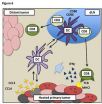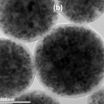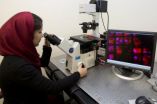(Press-News.org) A combination of iron-oxide nanoparticles and an alternating magnetic field, which together generate heat, have activated an immune system response to tumors in mice according to an accepted manuscript by Dartmouth-Hitchcock Norris Cotton Center researchers in the journal Nanomedicine: Nanotechnology, Biology and Medicine released online on February 24, 2014.
"The study demonstrates that controlled heating of one tumor can stimulate an immune response that attacks another tumor that has not had the heat treatment," said Steve Fiering, PhD, Norris Cotton Cancer Center researcher and professor of Microbiology and Immunology, and of Genetics at the Geisel School of Medicine at Dartmouth. "This is one way to try to train the immune system to attack metastatic tumors that may not be recognized yet."
Researchers injected iron-oxide nanoparticles into the tumor and then activated those agents with magnetic energy. Researchers were able to activate antigen-presenting dendritic cells in the body's immune system. Dendritic cells somewhat serve as "quarterbacks" for body's immune system by calling for quick coordinated protection against an attack. The "quarterback" cells show the defensive "killer" T cells (CD8+ cells) who to attack and these cells then directly attack tumor cells and send out an alert system to engage other cells in the fight against the cancer. The combination of these two aspects of the immune response reduce risk of recurrence and discourage spreading or metastasis of the cancer. This result was observed in sites close to the primary tumor as well as distant sites. In the experiments conducted as part of this study the primary tumor resisted regrowth for one month following overheating.
The magnetic hyperthermia system used was developed by co-author P. Jack Hoopes, DVM, PhD co-director of Norris Cotton Cancer Center's Nanotechnology Working Group. "It enables very precise control of the heating to keep the temperature at a uniform 43 degrees C for as long as desired," said Fiering. "This precise control was the key to optimal immune stimulation."
The experiment included mouse colon and, melanoma cancers. Tumors responded to the heat by growing more slowly or disappearing completely. A higher temperature was better at eliminating primary tumors that were heat treated, but did not activate the immune system as well to find and attack metastatic tumors. Treatment of larger primary tumors generated a stronger immune response.
In the effort to develop better cancer treatments, the challenge is to find ways to cure metastatic disease. "The use of the immune system through cancer immunotherapy is a very exciting field currently and promises to contribute significantly to elimination of metastatic tumors," said Fiering. "The approach demonstrated is a good new option to be combined with other immunotherapy strategies for cancer therapy."
Standard cancer care involves surgery, but surgeons have few tools to guarantee the removal of every cancer cell, especially when there is unrecognized metastases in other anatomic locations. An approach like local hyperthermia one day might be used to kick start the immune system to ward off any cancer cells not removed by surgery to increase the chances of treatment success.
INFORMATION:
The study was funded by NIH Grant # 1 U54 CA151662 and NIGMS P20 RR15639.
About Norris Cotton Cancer Center at Dartmouth-Hitchcock
Dartmouth has been designated as a Center of Cancer Nanotechnology Excellence (CCNE) with a five-year, $12.8 million grant from the National Cancer Institute (NCI). The CCNE places Dartmouth among top centers in cancer nanotechnology research nationwide and takes full advantage of Dartmouth's culture of cross-disciplinary collaboration. CCNEs are tasked with integrating nanotechnology into basic and applied cancer research in order to provide new solutions for the diagnosis and treatment of cancer.
Norris Cotton Cancer Center combines advanced cancer research at Dartmouth and the Geisel School of Medicine with patient-centered cancer care provided at Dartmouth-Hitchcock Medical Center, at Dartmouth-Hitchcock regional locations in Manchester, Nashua, and Keene, NH, and St. Johnsbury, VT, and at 12 partner hospitals throughout New Hampshire and Vermont. It is one of 41 centers nationwide to earn the National Cancer Institute's "Comprehensive Cancer Center" designation. Learn more about Norris Cotton Cancer Center research, programs, and clinical trials online at cancer.dartmouth.edu.
Dartmouth researchers find promising results with local hyperthermia of tumors
2014-03-04
ELSE PRESS RELEASES FROM THIS DATE:
Plant extract hope for infant muscle disease
2014-03-04
Their study is published today (3rd March 2014) in the Journal of Clinical Investigation.
The research team have found that a plant pigment called quercetin – present in some fruits, vegetables, herbs and grains – could help to prevent damage to the nerves associated with the childhood form of motor neurone disease, spinal muscular atrophy (SMA).
SMA, also known as 'floppy baby syndrome', is a leading genetic cause of death in children. It affects approximately one in 6,000 to 10,000 children and around half of children with the most severe form will die before the ...
Researchers develop antibody-targeted treatment for recurrent small-cell lung cancer
2014-03-04
Researchers at Norris Cotton Cancer Center have found an antibody that may be used in future treatments for recurrent small-cell lung cancer, which currently has no effective therapy. The mouse monoclonal antibody they have developed, MAG-1, targets the ProAVP surface marker. When given alone, it significantly slows the growth of tumor xenografts of human recurrent small-cell lung cancer in mice. The study, "Growth Impairment of Small-Cell Cancer by Targeting Pro-Vasopressin with MAG-1 Antibody," was recently published online in Frontiers in Oncology.
"We are developing ...
JCI online ahead of print table of contents for March 3, 2014
2014-03-04
Identification of factors that influence breast cancer metastasis to bone
One of the more serious and frequent complications of advanced breast cancer is bone metastasis, which is exacerbated by TGF-β signaling; however, it is not clear how TGF-β production is regulated prior to and during metastasis. In this issue of the Journal of Clinical Investigation, Guohong Hu and colleagues at the Shanghai Institutes for Biological Sciences evaluated murine models of invasive breast cancer and determined that cancer cells lacking the putative tumor suppressor DLC1 have ...
Youngest kindergarteners most likely to be held back, MU study finds
2014-03-04
COLUMBIA, Mo. -- For some parents, the decision of when to enroll their children into kindergarten can result in costly consequences such as another year of daycare expenses. In general, children must be five years old to be eligible to be enrolled in kindergarten. However, the developmental differences between a young kindergartener who barely qualifies for the state-mandated age cutoff date compared to a child who is almost year older, may have implications. Now, a University of Missouri researcher has found that the youngest kindergartners are about five times more likely ...
UC research tests which nano system works best in killing cancer cells
2014-03-04
In current research related to improving cancer treatments, one promising area of research is the effort to find ways to selectively pinpoint and target cancer cells while minimizing effects on healthy cells.
In that effort, it's already been found in lab experiments that iron-oxide nanoparticles, when heated and then applied specifically to cancer cells, can kill those cells because cancer cells are particularly susceptible to changes in temperature. Increasing the temperature of cancer cells to over 43 degrees Celsius (about 109 degrees Fahrenheit) for a sufficient ...
The chemistry (and fascinating history) of pepper, the spice that changed the world
2014-03-04
WASHINGTON, March 3, 2014 — Pepper is one of the most plentiful condiments in the world today, but it used to be more valuable than gold. In the American Chemical Society's (ACS') latest Reactions video, we examine how pepper's delectable chemistry made it a key player in the global spice trade. The sought-after spice helped usher in the "Age of Discovery," which bridged the gap between the Middle Ages and the Modern era. And because we're celebrating our second month of existence, it's a Reactions double feature this week. In our second video, we examine the science behind ...
Team models photosynthesis and finds room for improvement
2014-03-04
CHAMPAIGN, Ill. — Teaching crop plants to concentrate carbon dioxide in their leaves could increase photosynthetic efficiency by 60 percent and yields by as much as 40 percent, researchers report in a new study.
The team used a computer model to simulate how adding genes from a type of photosynthetic algae known as cyanobacteria might influence photosynthetic efficiency in plants. Cyanobacteria contain small structures, called carboxysomes, which concentrate carbon dioxide at the site of photosynthesis.
"Photosynthesis is the most studied of all plant processes, so ...
Scientists identify protein linked to most common movement disorder
2014-03-04
Quebec City, March 3rd, 2014—A team of researchers from Université Laval and CHU de Québec identified unusually high levels of a certain protein in the brains of people suffering from essential tremor (ET), a movement disorder that affects 4% of the adult population. The discovery, the details of which were published in the most recent edition of the journal Movement Disorders, could lead to an effective treatment for this neurological condition, which is 10 times more prevalent than Parkinson's disease.
As its name suggests, ET causes tremors in various parts of the ...
UC research tests range of electrical frequencies that help heal chronic wounds
2014-03-04
Naturally occurring electricity in our cells is key to how our bodies function, and that includes the healing of wounds.
And externally applied low-amplitude electric fields have been shown to help hard-to-heal chronic wounds, like those associated with diabetes, where there is insufficient blood supply and drug treatments are not effective. The externally applied electric field manipulates the body's naturally occurring electricity, such that the new vessels are formed, and blood supply to the wound is increased.
University of Cincinnati physics and biomedical engineering ...
Cigarette smoking may cause physical changes in brains of young smokers, UCLA study shows
2014-03-04
The young, it turns out, smoke more than any other age group in America. Unfortunately, the period of life ranging from late adolescence to early adulthood is also a time when the brain is still developing.
Now, a small study from UCLA suggests a disturbing effect: Young adult smokers may experience changes in the structures of their brains due to cigarette smoking, dependence and craving. Even worse, these changes can occur in those who have been smoking for relatively short time. Finally, the study suggests that neurobiological changes that may result from smoking ...




